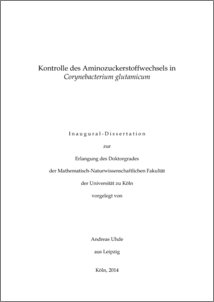Uhde, Andreas
(2014).
Kontrolle des Aminozuckerstoffwechsels in Corynebacterium glutamicum.
PhD thesis, Universität zu Köln.

![[img]](https://kups.ub.uni-koeln.de/style/images/fileicons/application_pdf.png)  Preview |
|
PDF
Dissertation_Uhde_Andreas.pdf
- Published Version
Download (2MB)
|
Abstract
Aminozucker, wie Glucosamin oder N-Acetylglucosamin, stellen für biotechno-logische Prozesse mit Corynebacterium glutamicum eine alternativer Kohlenstoffquelle dar. Als Bestandteil von Chitin sind sie weit verbreitet, können jedoch von C. glutamicum nur sehr schlecht oder, wie im Fall von N-Acetylglucosamin, gar nicht umgesetzt werden. Diese Arbeit beschreibt die Identifikation und Charakterisierung von Proteinen des Aminozuckerkatabolismus, die Wirkungsweise des an der Expression beteiligten Regulators und die Anwendung der erzielten Ergebnisse am Beispiel von L-Lysin-Produktionsstämmen.
Die Annotation des Genoms zeigte, dass die für den Katabolismus der Aminozucker notwendigen Enzyme NagA (N-Acetylglucosamin-6-phosphat-Deacetylase) und NagB (Glucosamin-6-phosphats-Deaminase) vorhanden sind. Über die Substratimporter war nichts bekannt. Durch die Aufnahmemessung radioaktiv markierter Substrate konnte der Glucose-Importer PTSGlc als Aufnahmesystem von Glucosamin ermittelt werden. PTSGlc hat zwar eine vergleichsweise geringe Affinität zu Glucosamin, der Substratimport stellt jedoch nicht den wachstumslimitierenden Schritt dar. Limitierend ist die Aktivität von NagB. Durch die Überexpression von nagB konnten die Wachstumsraten von C. glutamicum auf Glucosamin verdreifacht werden. Des Weiteren wurde der Regulator der nag-Gene identifiziert und der zugrunde liegende Regulationsmechanismus beschrieben. NanR ist ein Regulator der GntR-Familie, der neben den nag-Genen auch die Expression der unmittelbar benachbarten Gene des Sialinsäurekatabolismus (nan-Gene) reguliert. Die DNA-Bindedomäne von NanR erkennt ein spezifisches Motiv, bestehend aus zwei aufeinanderfolgenden Hexanukleotidsequenzen. Durch die Bindung von NanR im Promotor der nag- und nan-Gene wird deren Expression reprimiert.
N-Acetylglucosamin-6-phosphat und N-Acetylmannosamin-6-phosohat sind Effektoren von NanR, durch die der Repressor wieder von der DNA gelöst wird. Die gemeinsame Regulation der nag- und nan-Gene durch den gleichen Regulator ist bei Bakterien eine Ausnahme.
In L-Lysin Produktionsstämmen wurde die Überexpression von nagB sowie die Deletion von nanR angewandt, um Glucosamin als Substrat zur Aminosäureproduktion zu nutzen. Die erzielten Ausbeuten und Produktivitäten lagen im gleichen Bereich wie bei dem gut verwertbaren Substrat Glucose. Zur Nutzung von N-Acetylglucosamin wurde der heterologe Transporter NagE aus C. glycinophilum eingesetzt. Dabei blieb der Substratimport trotz der Überexpression limitierend. Eine effektive Nutzung von N-Acetylglucosamin konnte jedoch mit den Cosubstrat zu Glucose erzielt werden.
| Item Type: |
Thesis
(PhD thesis)
|
| Translated abstract: |
| Abstract | Language |
|---|
| Amino sugars such as glucosamine or N-acetylglucosamine are potential alternative carbon sources for biotechnological processes with Corynebacterium glutamicum. As part of chitin they are widely distributed. However, they cannot be used efficiently for growth by C. glutamicum. This work describes the identification and characterization of proteins required for amino sugar catabolism, the regulator that is involved and the application of these results exemplified in L-lysine production strains.
Genome annotations showed that the enzymes necessary for the catabolism of amino sugars NagA (N-acetylglucosamine-6-phosphate deacetylase) and NagB (glucosamine-6-phosphate deaminase) are available. Nothing was known about the substrate importers so far. Using radiolabeled substrates the glucose importer PTSGlc was identified as the sole uptake system for glucosamine. Although PTSGlc has a relatively low affinity for glucosamine, the import is not the growth-limiting step, but the activity of NagB. Over-expression of nagB in C. glutamicum tripled growth rates on glucosamine. Furthermore, the regulator of the nag-genes was identified and the underlying regulatory mechanism was described. NanR is a GntR-type regulator that represses the expression of the nag-genes and the closely adjacent nan-genes that are required for sialic acid catabolism. The DNA-binding domain of NanR recognizes a specific motif consisting of two consecutive hexanucleotides. Binding of NanR to the promoter of the nag- and nan-genes represses the initiation of transcription.
N-acetylglucosamine-6-phosphate and N-acetylmannosamine-6-phosphate are effectors of NanR whereby the repressor is released from the DNA. The joint regulation of the nag- and nan-genes by the same regulator is an exception among bacteria.
In L-lysine production strains over-expression of nagB and deletion of nanR was applied to use glucosamine as a substrate for amino acid production in C. glutamicum. Yields and productivities obtained were in the same range as in glucose fermentations. For the utilization of N-acetylglucosamine the heterologous transporter NagE from C. glycinophilum was over-expressed. However, substrate import was limiting so that N-acetylglucosamine could only be used effectively as a co-substrate of glucose. | English |
|
| Creators: |
| Creators | Email | ORCID | ORCID Put Code |
|---|
| Uhde, Andreas | andreasuhde@gmx.de | UNSPECIFIED | UNSPECIFIED |
|
| URN: |
urn:nbn:de:hbz:38-54980 |
| Date: |
February 2014 |
| Language: |
German |
| Faculty: |
Faculty of Mathematics and Natural Sciences |
| Divisions: |
Faculty of Mathematics and Natural Sciences > Department of Chemistry > Institute of Biochemistry |
| Subjects: |
Life sciences |
| Uncontrolled Keywords: |
| Keywords | Language |
|---|
| Corynebacterium glutamicum, NanR, Glucosamin, Lysin, N-Acetylglucosamin, Neuraminsäure, Regulation | German | | Corynebacterium glutamicum, NanR, glucosamine, lysine, N-acetylglucosamine, neuraminic acid, regulation | English |
|
| Date of oral exam: |
22 January 2014 |
| Referee: |
| Name | Academic Title |
|---|
| Krämer, Reinhard | Prof. Dr. | | Neundorf, Ines | Prof. Dr. |
|
| Refereed: |
Yes |
| URI: |
http://kups.ub.uni-koeln.de/id/eprint/5498 |
Downloads per month over past year
Export
Actions (login required)
 |
View Item |


